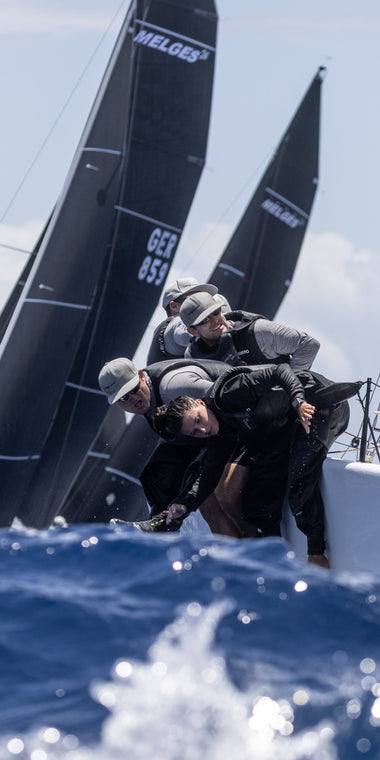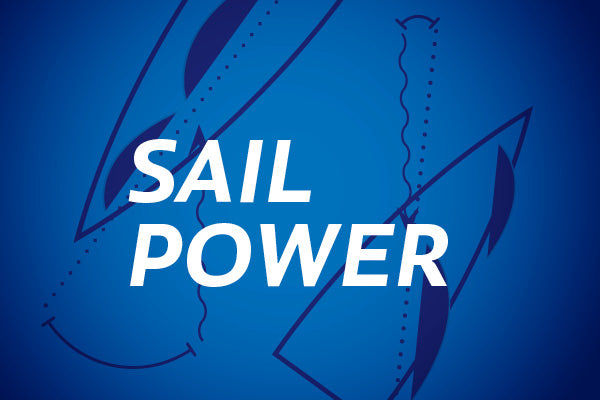FULL POWER & MIX OF POWER
SAIL POWER: FULL POWER & MIX OF POWER
By Bill Gladstone
This article is derived from the North U Trim Seminar. North U offers seminars, clinics, books, media, online training, and coaching. Visit NorthU.com to Learn More
In our first segment we defined the three sources of sail power: Angle of Attack, Depth, and Twist. Segment two focused on twist and the impact of twist on performance.
In this segment we address how our three sources of power combine to create our total power, how we add and reduce power to match the conditions, and how we can change not just the total power, but the mix of power. Later segments will explore the relationship between the main and jib and also describe how each of our sail controls impacts shape and power.
Optimum Performance
Each sail gets its power from a combination of angle of attack, depth and twist. It is time to explore how these combine and how we can adjust both the total and the mix of power to optimize performance in different wind speeds and sea states.
Total Power, Full Power, Mix of Power
Our first goal is to get to full power – neither overpowered nor underpowered. Full power means the crew are fully hiked, the boat has its designed angle of heel, and the helm is well balanced and easy to steer.

First, understand that we can trade one kind of power for another. We can add power from one source, reduce from another and have the same total but a different mix. For example: Adding depth adds power while adding twist spills power. By adding depth and increasing twist we can get the same total power, but a different mix.

Moderate Air Trim
By moderate air we mean enough wind to get the boat to full power – as described above, this means, the crew fully hiked and the boat sailing at its designed angle of heel, and the helm balanced. On most boats we transition from light air to moderate in 6 to 7 knots of true wind speed. Some boats need more, some less. Once we are at full power we can fine-tune performance by changing the mix of power. Here’s what we mean:
Waves or Chop
In wavy conditions a deeper more twisted shape is preferred. The extra depth provides power to punch through the waves and better acceleration to build speed as each wave slows the boat, while the extra twist provides a wider steering groove and is less prone to stalling. The waves make a narrow course hard to hold, and each wave slows the boat, so we are constantly accelerating.
The downside is a slight compromise in pointing ability compared to smooth water sailing. But remember: you’ll never point if you are slow. Speed First.
Similarly, coming out of a tack our sails are initially trimmed with extra twist to ease flow at a wider angle of attack, and with extra depth for acceleration, with final trim coming only as the boat accelerates to full speed and is brought up to a narrower, high pointing angle of attack.
Smooth Water
In smooth water and that same full power wind speed we trim with less twist – adding power and pointing ability – while sailing with a flatter sail – reducing power and drag. We have the same total power, but a different mix.
The downside to flat sails with little twist is a narrower steering groove and poor acceleration. In smooth water we can sail in a narrower groove, and once we are up to speed we won’t be slowed by waves. It only works if you can sail to it; you won’t point well if you use high pointing trim in unsuitable conditions. You’ll just stall and go slow.

Across the Spectrum
We’re rarely in perfectly smooth or ferociously chopping conditions. Mostly we sail in something in between. For best performance we’ll adjust the mix of depth and twist to suit the prevailing conditions while maintaining full power. The differences are nuanced and often the performance advantage is small… but critical. The difference between good and great, between mid-fleet and winning is just a couple percent and is often comprised of several things each contributing fractions of a percent. Never relent. Every little increment matters. It adds up.

Next Time…
In our next segment we’ll look at the role of Angle of Attack in upwind performance and look at de-powering in heavy air and powering-up in light air.
© copyright Bill Gladstone



























